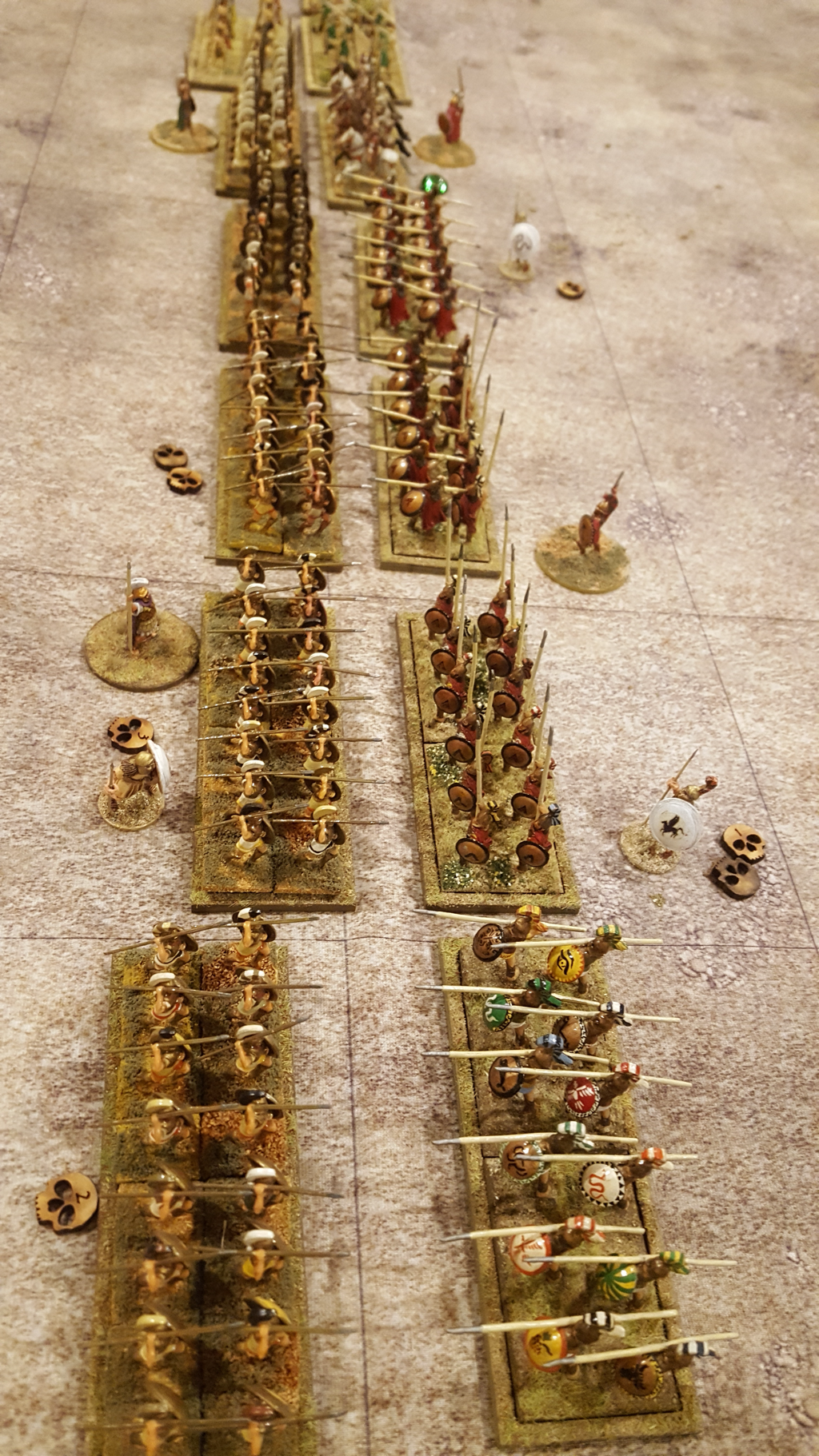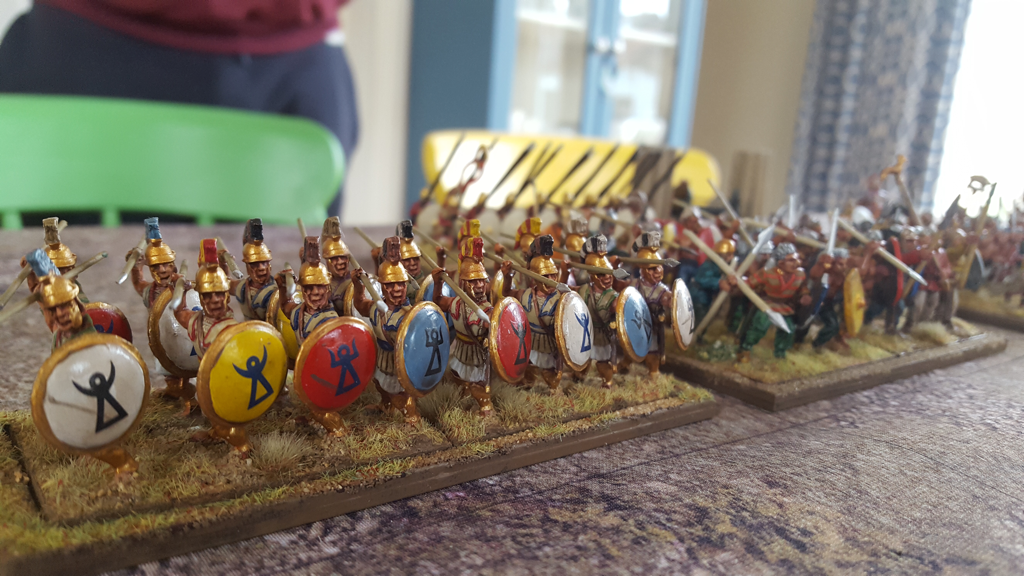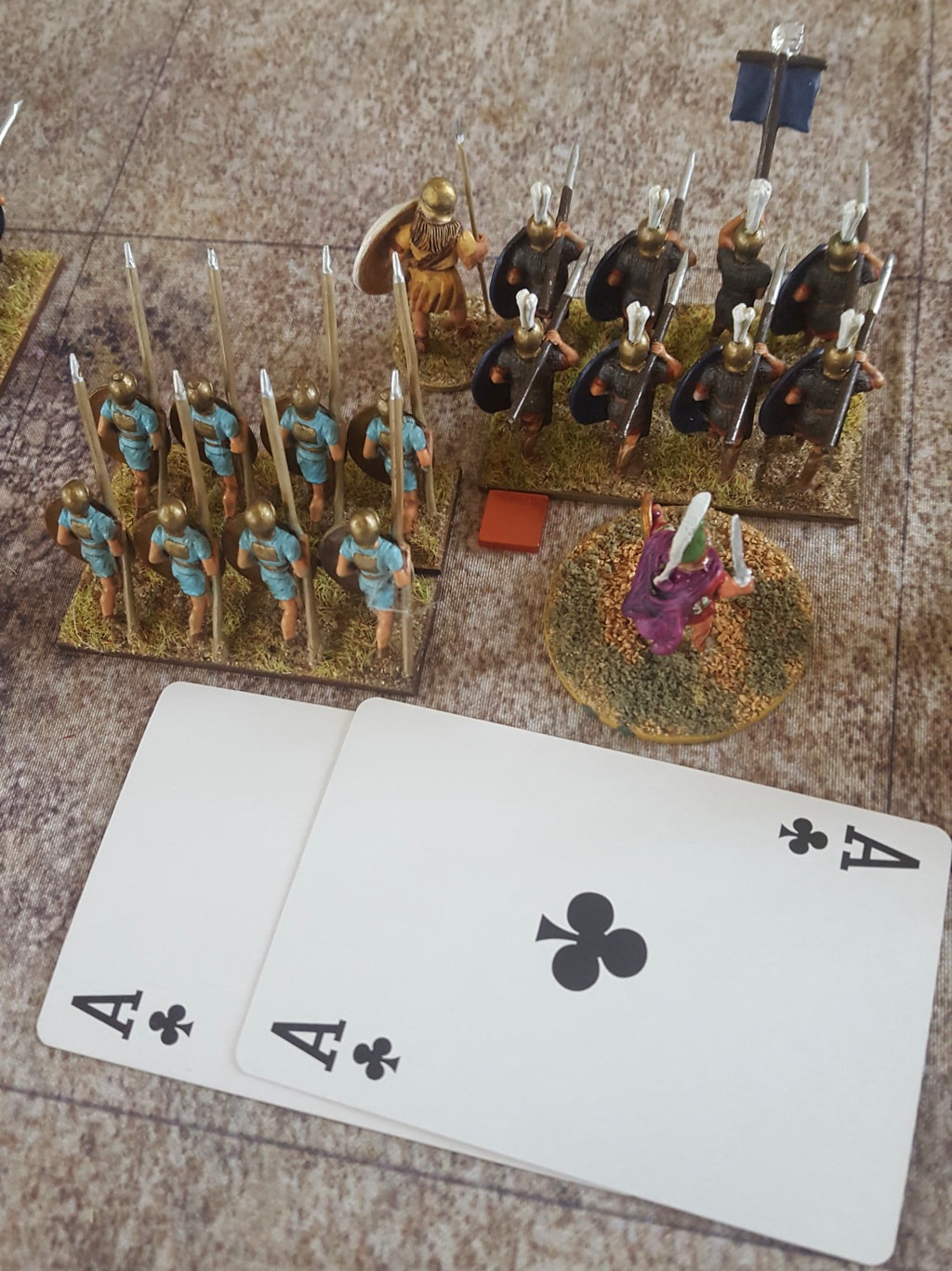|
Over the Easter weekend I was able to play two socially distanced wargames with my son Nick, using the To the Strongest rules (TtS) by Simon Miller. We play TtS with 25mm figures on a 6” grid. The figures are a mix of ages and manufacturers, some of them dating back to 1981 when, aged 21, I started collecting Classical Greeks by Minifigs and by the long-defunct Rospaks. I have added to the collection over the years, with both modern sculpts by First Corps and Newline Designs and older models picked up through eBay or gifted by a friend who has downsized to 15s. I now have Greeks, Macedonians, Gauls, Iberians, Carthaginians and Republican Romans. The Romans are an entire army of very early Minifigs from the collection of a gamer who had passed away. I felt honoured to re-home them. Their spears are like telegraph poles and sculpting definition can be fuzzy but they have great character. And unlike so many ‘heroic’ scale figures, their proportions are realistic. To my eye, too many 28s today look like Space Marines in togas. But I digress! The death of LeonidasOur first game was a battle between my Athenians and Nick’s Spartans. His hoplites had the qualitative edge while I had more lights. While the two flanks bickered, our centres got stuck in, with Nick’s lads doing marginally better. We both had success with our left flank forces, so as the fight developed, each of our right flanks had to deal with the danger of being rolled up. I was losing victory medals faster than Nick but then had the good fortune to kill his heroic general, which brought our losses into balance. The cards went my way next turn, destroying one more Spartan hoplite unit and the battle was mine. The whole thing was very close however and at game’s end I had only one victory medal surviving. Still, a win is a win! The game felt very satisfying as a clash between two hoplite armies, with no fancy manoeuvres and no detached generals. Our lights kept busy fighting each other but the game’s outcome was decided by the hoplites. Hannibal ad portasGame two was between Nick’s Carthaginians and my Romans. I was seriously outnumbered and Nick set out to envelop my army. On the other hand my infantry were rock hard and their pila gave them an edge on the first turn of combat. I set out to demolish Nick’s centre while I refused both of my flanks and kept my triarii back to act as a fire brigade. Nick placed all his cavalry on his right flank and two units of elephants on his left, along with some high quality Iberian Scutarii. My centre started well, doing serious damage to some Gauls and wiping out a unit of citizen spearmen. However, the general in command of my centre then missed a turn at a key moment when he drew two aces in succession on his first activation. This allowed Nick time to patch up his centre while his left wing trundled down as far as my baseline and turned to face inwards. I squandered my next turn in a bout of tunnel vision, trying multiple activations on one unit so it could destroy a double-disordered unit of Gauls. Of course I failed the third activation on my unit and so ended the turn without activating a single other unit in the Command. I know, I know! Basic mistake and I should never be so dumb, except I was so fixated on the opportunity to destroy the single enemy unit I was attacking that I completely forgot my own advice. Meanwhile Nick’s left wing started grinding down the troops defending my right rear, as well as threatening my front line from the side. At this point our lines were in an ‘L’ shape, with particular pressure on my units in the angle. Then in one turn, a flurry of high card hits by Nick, met with low card failed saves by me, took him comfortably over the victory line. To his only slight disappointment, he had won without his elephants actually fighting anybody. But we agreed that they had done great work forcing me to conform to their advance. How (not) to play Republican RomansThat didn’t go well for me, but as we played we agreed some resolutions for the next time the Romans fight. Ideally, we would seek to use terrain to negate the enemy’s numerical advantage. In this game, it was Nick who exploited rough ground to shelter his advance down his left flank. Next, the Roman shouldn’t wait around to be outflanked by a bigger force: the heavy infantry should get stuck in quickly and try to eat up the enemy centre before the flanks and rear are threatened. Once engaged, the first priority each turn must be to use the Romans’ special line exchange rule for every unit that is disordered (representing the fresh principes replacing the tired hastati in the front line). This is a really powerful advantage but I lacked the discipline to sort out the line before other activations. At least twice, my command’s turn ended before I had attempted a line exchange. Finally, we decided that if possible, every command should have just one main function. My centre command Included both front line units and my reserve. Besides making it a very big command, I was trying to deploy the triarii to face Nick’s flank attack and to fight his centre to the front. Too often, the command’s turn ended before one group or the other had completed its tasks. It is of course one thing to draw conclusions after a game but entirely another to remember them next time I play. And in case I haven’t made it clear: I didn’t ‘throw’ the game. Nick conclusively won it, making great use of his army’s strengths and obliging me to respond to his movements. A classy win for Carthage. Out of lockdown with To the StrongestThe second game was much more fluid than the hoplite encounter had been and it felt a bigger challenge for both of us. The card activation system in To the Strongest is inspired. A sensible player can minimise the risk of their turn ending prematurely but very occasionally, as when I drew two aces in succession at the start of one turn, bad luck just happens. Fair enough. On the other hand, it is all too easy for an idiot like me to get drawn into the drama of a single combat and completely forget that I should be taking care of other activations before trying again with the critical combat. I reckon a game that draws me in so completely is doing something right.
I remember that when I first read the TtS rules, I wondered if units had enough hits/lives to sustain a good game. I also worried that a squared grid might be too restrictive on movement. Neither concern survived contact with actual play. I very soon concluded that these rules are perfectly gauged to give an exciting and rewarding game, with the strong sense of what I would expect from an ancient battle. They are also so easy to learn and (crucial at my age!) to remember during play. After months and months without a face to face game, it was wonderful to be playing again. Fingers crossed, if the road map out of lockdown stays on track, we can soon play a great many more.
4 Comments
|
Archives
November 2023
Categories
All
|




 RSS Feed
RSS Feed